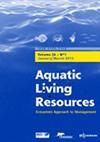基于脂肪酸和稳定同位素的综合多营养淡水池塘鱼类食物偏好
IF 1.9
4区 农林科学
Q3 FISHERIES
引用次数: 0
摘要
综合多营养水产养殖(IMTA)是一种通过饲养不同营养水平的物种来解决生物污泥的解决方案。在欧洲的淡水鱼塘中,普通鲤鱼通常与次要鱼类一起养殖。开发循环IMTA系统需要更好地了解鱼类之间营养相互作用的复杂性。脂肪酸和碳氮稳定同位素的分析是确定鱼类食物偏好的合适工具。在池塘中调查了三种IMTA系统,包括鲤鱼,蟑螂,陆克鱼和鲈鱼:半集约化(SI)池塘,鱼被喂食颗粒;一个半集约化池塘,鱼被喂食颗粒,加上一个种植了大型植物(SIC)的泻湖;以及一个不给鱼喂颗粒的大池塘。在SI和SIC池中,鲤鱼、蟑螂和陆克鱼的脂肪酸谱与颗粒接近。鱼类的δ13C和δ15N值证实了它们主要以颗粒为食,但蟑螂和陆克虫的饮食中也含有天然食物来源。在E池中,鲤鱼、蟑螂和陆克鱼的脂肪酸谱略有差异,但δ13C和δ15N值相似。混合模型表明,E池鱼类主要以浮游动物为食。不考虑IMTA系统,脂肪酸和稳定同位素分析表明幼鱼主要食用大型浮游动物。在三个系统中,鲈鱼的FA曲线与幼鱼的FA曲线接近。混合模型估计,鲈鱼以大型浮游动物和小龙虾补充它们的饮食。在SI和SIC池塘中,商业颗粒的分布驱动了鱼类之间的营养相互作用。在E池中,由于资源有限,鱼类有明显的摄食重叠。本文章由计算机程序翻译,如有差异,请以英文原文为准。
Food preferences of fish in integrated multi-trophic aquaculture freshwater ponds based on fatty acids and stable isotopes
Integrated multi-trophic aquaculture (IMTA) is a solution to biomitigate waste by rearing species from different trophic levels. In European freshwater fishponds, common carp is often produced along with secondary fish species. Developing recycling IMTA systems requires better understanding of the complexity of trophic interactions between fish. Analyses of fatty acid and stable isotopes of carbon and nitrogen are suitable tools for determining food preferences of fish species. Three IMTA systems, including carp, roach, rudd and perch, were investigated in ponds: a semi-intensive (SI) pond in which fish were fed pellets; a semi-intensive pond in which fish were fed pellets, coupled with a lagoon planted with macrophytes (SIC); and an extensive (E) pond in which fish were not fed pellets. In the SI and SIC ponds, fatty acid profiles of carp, roach and rudd were closed to those of pellets. The δ13C and δ15N values of fish confirmed that they mainly fed on pellets, but the diet of roach and rudd also contained natural food sources. In the E ponds, fatty acid profiles of carp, roach and rudd slightly differed but their δ13C and δ15N values were similar. Mixing model indicated that fish from E ponds mainly fed on zooplankton. Regardless of the IMTA systems, fatty acid and stable isotope analyses indicated that juveniles consumed mainly large zooplankton. In the three systems, the FA profile of perch was closed to that of juvenile fish. Mixing model estimated that perch supplemented their diet with large zooplankton and crayfish. In the SI and SIC ponds, the distribution of commercial pellets drove the trophic interactions among fish. In the E ponds, fish had significant feeding overlap due to the limited resources available.
求助全文
通过发布文献求助,成功后即可免费获取论文全文。
去求助
来源期刊

Aquatic Living Resources
农林科学-海洋与淡水生物学
CiteScore
2.30
自引率
0.00%
发文量
10
审稿时长
>24 weeks
期刊介绍:
Aquatic Living Resources publishes original research papers, review articles and propective notes dealing with all exploited (i.e. fished or farmed) living resources in marine, brackish and freshwater environments.
Priority is given to ecosystem-based approaches to the study of fishery and aquaculture social-ecological systems, including biological, ecological, economic and social dimensions.
Research on the development of interdisciplinary methods and tools which can usefully support the design, implementation and evaluation of alternative management strategies for fisheries and/or aquaculture systems at different scales is particularly welcome by the journal. This includes the exploration of scenarios and strategies for the conservation of aquatic biodiversity and research relating to the development of integrated assessment approaches aimed at ensuring sustainable and high quality uses of aquatic living resources.
 求助内容:
求助内容: 应助结果提醒方式:
应助结果提醒方式:


